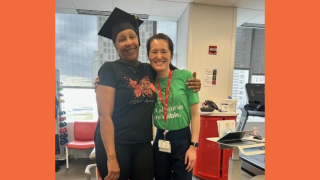Body
The early detection of cerebral palsy is important for your child, your family and for your medical team. The early engagement of you and your child with physical therapy and professionals that understand cerebral palsy will maximize your child's potential. We are committed to assisting your family in the process and creating opportunities for success in development and function through the rehabilitation process.
Deb Gaebler
Attending Physician, Shirley Ryan AbilityLab
Please consult this list of resources to assist in the journey and importance of early identification with Cerebral Palsy.
Body
NIH: Cerebral Palsy Information Page:
“The early signs of cerebral palsy usually appear before a child reaches 3 years of age. The most common are a lack of muscle coordination when performing voluntary movements (ataxia); stiff or tight muscles and exaggerated reflexes (spasticity); walking with one foot or leg dragging; walking on the toes, a crouched gait, or a “scissored” gait; and muscle tone that is either too stiff or too floppy.”
Cerebral Palsy Alliance: Early Diagnosis of Cerebral Palsy
A wonderful list of fact sheets to help aid in the discovery of information in early diagnosis.
Cerebral Palsy Foundation – Fact Sheet Library
See fast and easy understandable information on causes, timing, signs and symptoms. It has a great website complete with a video library, fact sheets and access to a CP Channel - Free App by linking to the hyperlink below.
CP Channel - free Cerebral Palsy Foundation App
Cerebral Palsy, except in its mildest forms, can be evident in the first 12 -18 months.
CDC - Screening and Diagnosis of Cerebral Palsy – CDC – Early Detection
Diagnosing cerebral palsy (CP) at an early age is important to the well-being of children and their families.
Learn about the diagnostic process: Developmental Monitoring, Developmental Screening, Developmental and Medical Evaluations
Medicaid’s Early and Periodic Screening, Diagnostic, and Treatment Benefit
The Early and Periodic Screening, Diagnostic and Treatment (EPSDT) benefit provides comprehensive and preventive health care services for children under age 21 who are enrolled in Medicaid. EPSDT is key to ensuring that children and adolescents receive appropriate preventive, dental, mental health, and developmental, and specialty services.
- Early: Assessing and identifying problems early
- Periodic: Checking children's health at periodic, age-appropriate intervals
- Screening: Providing physical, mental, developmental, dental, hearing, vision, and other screening tests to detect potential problems
- Diagnostic: Performing diagnostic tests to follow up when a risk is identified, and
- Treatment: Control, correct or reduce health problems found.

Nationwide Children’s Hospital has a pdf online for
“Early Diagnosis and Intervention Guidelines for Cerebral Palsy”
CanChild – Cerebral Palsy FAQ’s page
CanChild is proud to be a member of the Cerebral Palsy Integrated Network (CP-NET), a program designed to improve our understanding of CP and accelerate the development of new treatments.
Pathways.org - Guide to Growth and Development
Pathways.org is a 501(c)(3) not-for-profit organization providing FREE child development information to empower parents and health professionals.
Funding, Resources, and Support:
IDHS Illinois Department of Human Services EI Early Intervention Program
Illinois' Early Intervention program's mission is to assure that families who have infants and toddlers, birth to three, with diagnosed disabilities, developmental delays or substantial risk of significant delays receive resources and supports that assist them in maximizing their child's development, while respecting the diversity of families and communities.
Illinois Early Intervention Clearinghouse
This site explains Illinois Early intervention process and products that may be available through this assistance.
You might also be interested in:
Cerebral Palsy - What's Next in Childhood diagnosis
Ages 3 -12



